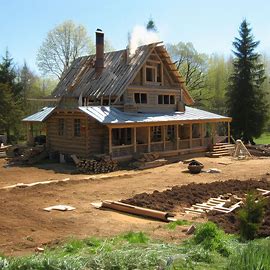
The Key Elements of Homestead Design: How to Achieve the Perfect Balance
Homestead design is not only about creating a beautiful space but also about functionality and sustainability.
Achieving the perfect balance between these elements can be challenging, but it's essential to create a harmonious and comfortable living environment.
In this article, we'll explore the key elements of homestead design and how to incorporate them into your home.
From selecting the right materials and colors to optimizing your space and creating a sustainable lifestyle, we'll cover everything you need to know to create a homestead that is both aesthetically pleasing and functional.
Whether you're a seasoned homesteader or just starting, this guide will provide you with valuable insights and practical tips to help you create the perfect homestead design that meets all your needs.
So, let's dive in and discover the secrets of homestead design!
Understanding the Basic Elements of Homestead Design
Homestead design is a combination of various elements, including functionality, sustainability, aesthetics, and comfort.
Understanding these elements is the first step towards achieving the perfect balance in your homestead design.
Functionality: Homestead design should be functional and practical.
It should meet the needs of the household and provide a comfortable living environment.
The design should be tailored to the specific needs of the household, taking into account factors such as family size, lifestyle, and daily routines.
Sustainability: Homestead design should be sustainable and environmentally friendly.
It should incorporate green living practices and utilize renewable resources.
This includes using energy-efficient appliances, implementing water conservation measures, and utilizing natural sources of light and ventilation.
Aesthetics: Homestead design should be aesthetically pleasing and reflect the personal style of the household.
It should create a warm and inviting atmosphere that promotes relaxation and comfort.
Comfort: Homestead design should provide a comfortable living environment that promotes well-being and relaxation.
This includes creating spaces that are conducive to rest and relaxation, such as cozy reading nooks and comfortable seating areas.
The Importance of Balance in Homestead Design
Achieving the perfect balance between these elements is crucial to creating a harmonious and comfortable living environment.
A homestead that is too focused on functionality may lack aesthetic appeal, while a homestead that is too focused on aesthetics may sacrifice functionality.
Likewise, a homestead that is not sustainable may have a negative impact on the environment and the household's budget.
Therefore, it is essential to strike a balance between these elements to create a homestead that meets all your needs.
By achieving this balance, you can create a space that is both functional and aesthetically pleasing while utilizing sustainable practices.
Creating a Homestead Design Plan
Creating a homestead design plan is essential to achieving the perfect balance between functionality, sustainability, aesthetics, and comfort.
A homestead design plan should take into account the specific needs of the household and incorporate green living practices.
The first step in creating a homestead design plan is to assess your needs.
This includes determining the number of bedrooms, bathrooms, and other living spaces required for your household.
You should also consider your lifestyle and daily routines to ensure that the design meets your needs.
The next step is to consider sustainability.
This includes utilizing green living practices such as implementing water conservation measures, using energy-efficient appliances, and utilizing natural sources of light and ventilation.
Once you have assessed your needs and incorporated sustainability measures, you can begin to focus on aesthetics and comfort.
This includes selecting the right colors, materials, and furniture to create a warm and inviting atmosphere.
Choosing the Right Materials for Your Homestead Design
Choosing the right materials is essential to achieving the perfect balance between functionality, sustainability, aesthetics, and comfort.
Materials should be durable, environmentally friendly, and aesthetically pleasing.
When selecting materials, consider their durability and environmental impact.
You should choose materials that are long-lasting and require minimal maintenance.
You should also consider the environmental impact of the materials, choosing those that are sustainably sourced and produced.
Additionally, you should consider the aesthetic appeal of the materials.
This includes selecting materials that complement the overall design of your homestead while creating a warm and inviting atmosphere.
Incorporating Natural Elements into Your Homestead Design
Incorporating natural elements into your homestead design is an excellent way to achieve the perfect balance between functionality, sustainability, aesthetics, and comfort.
Natural elements can include plants, natural light, and ventilation.
Plants are an excellent way to add a touch of nature to your homestead design while improving air quality and promoting relaxation.
You can incorporate plants into your design by adding a small herb garden or creating a plant wall.
Natural light and ventilation are also important elements of homestead design.
Natural light can help to create a warm and inviting atmosphere, while ventilation can improve air quality and promote relaxation.
Tips for Achieving Balance in Your Homestead Design
Achieving the perfect balance between functionality, sustainability, aesthetics, and comfort can be challenging.
However, there are several tips you can follow to help you achieve this balance.
One tip is to focus on functionality first. Start by designing a space that meets the needs of the household, then incorporate sustainability measures and aesthetic elements.
Another tip is to utilize space-saving techniques. This includes utilizing multifunctional furniture and storage solutions.
You should also consider the flow of your homestead design.
Ensure that the design promotes easy movement throughout the space and creates a sense of balance and harmony.
Examples of Successful Homestead Design
Many homesteads around the world have achieved the perfect balance between functionality, sustainability, aesthetics, and comfort.
One such example is the Natura Loft Homestead in Singapore.
This homestead incorporates sustainable practices such as rainwater harvesting and utilizes natural light and ventilation to create a warm and inviting atmosphere.
Another example is the Edgeland House in Texas, which utilizes sustainable practices such as geothermal heating and cooling and incorporates natural elements such as a green roof and a natural pool.
Common Homestead Design Mistakes to Avoid
While homestead design can be challenging, there are several common mistakes to avoid.
One mistake is focusing too much on aesthetics and sacrificing functionality.
Another mistake is neglecting sustainability measures and not utilizing renewable resources.
Additionally, many homeowners overlook the importance of incorporating natural elements into their homestead design.
This can result in a space that feels sterile and lacks warmth and comfort.
Conclusion: Achieving the Perfect Balance in Your Homestead Design
In conclusion, achieving the perfect balance between functionality, sustainability, aesthetics, and comfort is essential to creating a harmonious and comfortable living environment.
By understanding the basic elements of homestead design and incorporating sustainable practices, you can create a space that meets all your needs.
Remember to focus on functionality first, utilize space-saving techniques, and incorporate natural elements into your design.
By following these tips and avoiding common homestead design mistakes, you can achieve the perfect balance in your homestead design and create a space that is both functional and aesthetically pleasing while utilizing sustainable practices.
